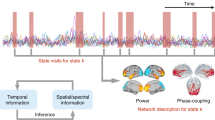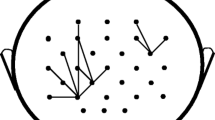Abstract
We consider the analysis of brain networks based on multi-electrode neural recordings. Granger causality and its spectral decomposition are used to assess the directions of dynamic interactions. The effectiveness of the method is illustrated by applying it to simulated data. Then multichannel local field potential recordings from monkeys performing a visuomotor pattern recognition task are analyzed to gain deeper understanding of the organization and functionality of large-scale oscillatory cortical networks.
Similar content being viewed by others
References
Akaike H (1974) A new look at statistical model identification. IEEE Trans Autom Control AC-19:716–723
Baccala LA, Sameshima K (2001) Partial directed coherence: a new concept in neural structure determination. Biol Cybern 84:463–474
Bernasconi C, Konig P (1999) On the directionality of cortical interactions studied by structural analysis of electrophysiological recordings. Biol Cybern 81:199–210
Bernasconi C, von Stein A, Chiang C, Konig P (2000) Bi-directional interactions between visual areas in the awake behaving cat. NeuroReport 11:689–692
Blair RC, Karniski W (1993) An alternative method for significance testing of waveform difference potentials. Psychophysiology 30:518–524
Bressler SL, Coppola R, Nakamura R (1993) Episodic multiregional cortical coherence at multiple frequencies during visual task performance. Nature 366:153–156
Brovelli A, Ding M, Ledberg A, Chen Y, Nakamura R, Bressler SL (2004) Beta oscillatory in a large-scale sensorimotor cortical network: directional influences revealed by Granger causality. Proc Natl Acad Sci 101:9849–9854
Chen Y, Bressler SL, Ding M (2008, in press) Frequency decomposition of conditional Granger causality and application to multivariate neural field potential data. J Neurosci Methods
Ding M, Bressler SL, Yang W, Liang H (2000) Short-window spectral analysis of cortical event-related potentials by adaptive multivariate autoregressive modelling: data preprocessing, model validation, and variability assessment. Biol Cybern 83:35–45
Felleman DJ, Essen DCV (1991) Distributed hierarchical processing in the cerebral cortex. Cereb Cortex 1:1–47
Freiwald WA, Valdes P, Bosch J et al. (1999) Testing non-linearity and directedness of interactions between neural groups in the macaque inferotemporal cortex. J Neurosci Methods 94:105–119
Geweke J (1982) Measurement of linear dependence and feedback between multiple time series. J Am Stat Assoc 77:304–313
Geweke J (1984) Measures of conditional linear dependence and feedback between time series. J Am Stat Assoc 79:907–915
Goebel R, Roebroek A, Kim D, Formisano E (2003) Investigating directed cortical interactions in time-resolved fMRI data using vector autoregressive modeling and Granger causality mapping. Magn Reson Imaging 21:1251–1261
Gourierous C, Monfort A (1997) Time series and dynamic models. Cambridge University Press, London
Granger CWJ (1969) Investigating causal relations by econometric models and cross-spectral methods. Econometrica 37:424–438
Hesse W, Moller E, Arnold M, Schack B (2003) The use of time-variant EEG Granger causality for inspecting directed interdependencies of neural assemblies. J Neurosci Methods 124:27–44
Kaminski M, Ding M, Truccolo WA, Bressler SL (2001) Evaluating causal relations in neural systems: Granger causality, directed transfer function and statistical assessment of significance. Biol Cybern 85:145–157
Raftery AE (1986) Choosing models for cross-classifications. Am Sociol Rev 51:145–146
Raftery AE (1995) Bayesian model selection in social research. In: Marsden PV (ed) Sociological methodology 1995. Blackwell, Cambridge, pp 111–163
Wiener N (1956) The theory of prediction. In: Beckenbach EF (ed) Modern mathematics for engineers, Chap 8. McGraw-Hill, New York
Author information
Authors and Affiliations
Corresponding author
Rights and permissions
About this article
Cite this article
Chen, Y., Bressler, S.L. & Ding, M. Dynamics on networks: assessing functional connectivity with Granger causality. Comput Math Organ Theory 15, 329–350 (2009). https://doi.org/10.1007/s10588-008-9039-x
Published:
Issue Date:
DOI: https://doi.org/10.1007/s10588-008-9039-x




